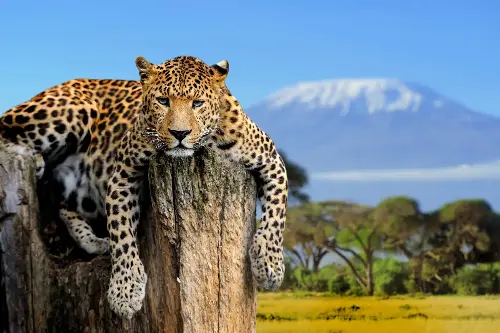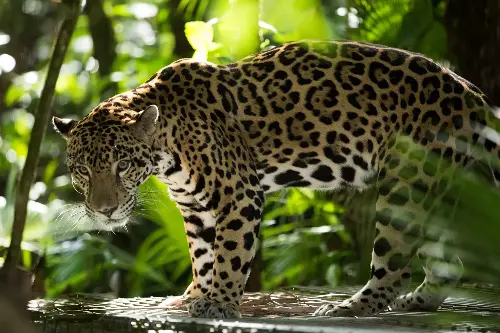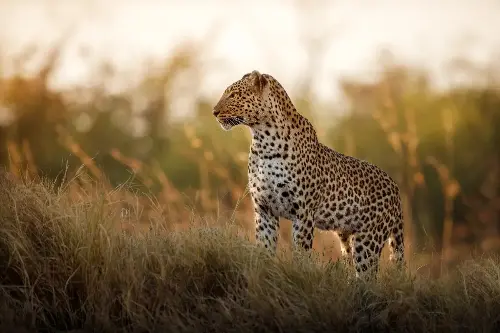In the animal kingdom's grand tapestry, two rosette-spotted felines have often mesmerised and perplexed admirers – the jaguar and the leopard. These big cats are living remnants of Nature's artistry, cloaked in similar patterns but divergent in behaviour, habitat, and strength. Prepare to untangle the intricate yarn of evolutionary divergence that defines these two majestic creatures.
Decoding the Spots: A Tale of Distinct Patterns

At first glance, jaguars and leopards can be mistaken for one another, with both sporting gorgeous coats dotted with rosettes. However, a closer inspection reveals the uniqueness of their markings. Jaguars are typically stockier with larger, denser rosettes on their coats, which often contain spots inside them. These spots are an evolutionary adaptation to their surroundings in the dense rainforest, where dappled light filters through the canopy, offering them camouflage.
Leopards, on the other hand, have smaller and more tightly packed rosettes with no central spots. Their fur pattern is an evolutionary response to their varied habitats, ranging from grasslands to forests in Africa and Asia, helping them merge into the shadows and underbrush with stunning effectiveness.
Strength and Stealth: The Power of the Jaguar

Jaguars are the third-largest cats in the world, after tigers and lions, but when it comes to bite strength, they lead the pack. Their jaws are robust enough to break through the tough exterior of caiman skin and even penetrate turtle shells. Their hunting technique is a testament to their power – while leopards will go for the neck, jaguars often deliver a mortal blow directly to the skull.
Living predominantly in the Americas, these powerful felines are skilled swimmers and often hunt in water. They are well adapted to the wet environments of the Amazon basin, and they use their strength to good effect, dragging large prey such as capybaras and deer through thick underbrush and into trees, away from other predators.
The Leopard's Lethal Prowess

Leopards may be smaller when compared to jaguars, but they are no less formidable. Excelling in stealth and adaptability, they are solitary hunters known for their ability to go undetected until the moment they strike. They're also surprisingly strong for their size, capable of hoisting kills that weigh as much as they do high into the branches of trees to keep them from scavengers. This tree-climbing proficiency also allows them to survey their territory and spot potential prey from a distance.
The leopard's versatility is echoed in their dietary preferences, feeding on a wide range of animals. This adaptability extends to their habitat choices as well; despite facing habitat loss, they are among the most widespread of big cats, with populations scattered from the African savannas to the forests of Asia.
Survival Tactics: Adapt and Overcome
Both jaguars and leopards have evolved to survive and thrive in their respective environments. Jaguars, being top predators in their ecosystems, have fewer concerns except from humans. They maintain territories that can span dozens of square miles, and they use water not only as a hunting ground but as a pathway, swimming effortlessly across rivers and streams.
Leopards, though equally stealthy, often have to share their territory with other large predators such as lions and hyenas, which forces them to be even more secretive and strategic. Solitude is paramount for their survival, and they may alter their activity patterns to avoid competitors, becoming nocturnal in areas where they are not the dominant carnivore.
Unfortunately, both animals face pressing threats from human activities, including habitat destruction, poaching for their beautiful pelts, and conflicts with livestock owners. Conservation efforts are critical to ensure that these remarkable cats don't fade into the annals of extinct species.
Enduring Legacy: Cultural and Ecological Impact
Jaguars and leopards are not just apex predators; they are integral to the cultural lore and ecological balance of their habitats. Native tribes in the Americas regard the jaguar as a spirit companion and symbol of power. Similarly, the leopard is revered in many African cultures, seen as a symbol of grace and strength.
Ecologically, these animals help maintain healthy populations of prey species by targeting the weak and sick; thus, they play a crucial role in the natural control of diseases and helping to maintain the diversity of species within their realm.
The Path Ahead
While jaguars and leopards share the perilous path of survival, their role in the biodiversity of our planet is unmatched. The tale of these two cats, with all their differences in spots, strength, and tactics, is one of nature's finest testaments to the beauty of evolution and adaptation. As we continue to share our world with these remarkable creatures, it's essential to commit to their conservation, ensuring that the jaguar's might and the leopard's stealth continue to be witnessed for generations to come.
The tale of two cats, jaguars and leopards, offers a fascinating glimpse into the ways nature tailors each species to its environment. Despite their similarities in appearance, their differences in strength, hunting strategies, and survival tactics are profound. By unravelling their stories, we gain not only an appreciation for these magnificent animals but also a reminder of our responsibility to protect them and their habitats.
